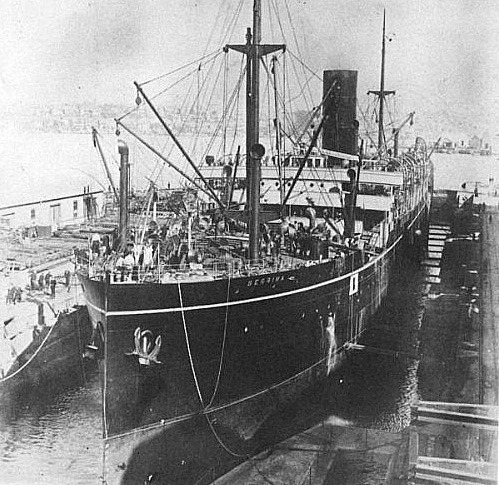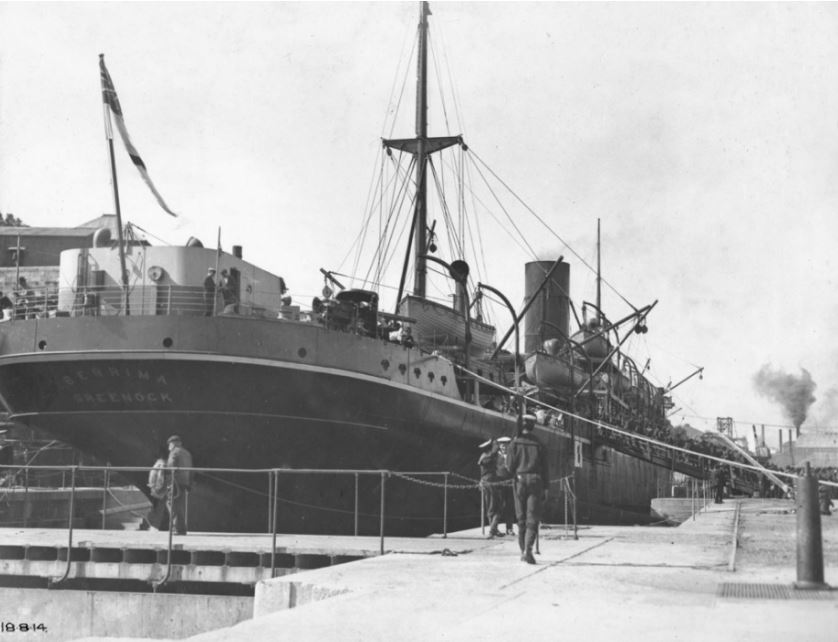Difference between revisions of "HMAT A35 Berrima"
From Our Contribution
(→Other Voyages) |
|||
| (43 intermediate revisions by the same user not shown) | |||
| Line 1: | Line 1: | ||
| − | {{Infobox | + | {{Infobox ship |
| − | | | + | | image = [[File:HMAT_A35_Berrima.jpg|border|600px]] |
| + | | caption = Berrima under construction in 1913 - Wikipedia | ||
| + | | image2 = [[File:HMAT_A35_Berrima_2.jpg]] | ||
| + | | caption2 = 18 August 1914 (Stern view at Cockatoo Island) | ||
| + | | shipname = HMAT A35 Berrima | ||
| + | | shipowner = Peninsular & Oriental Steam Navigation Co | ||
| + | | shipbuilder = Caird & Co, Greenock, Scotland | ||
| + | | shipyardnumber = | ||
| + | | shiplaunched = 20 Sep 1913 | ||
| + | | shipcompleted = 1914 | ||
| + | | shipinservice = 17 Aug 1914 | ||
| + | | shipoutofservice = | ||
| + | | shipinservice2 = | ||
| + | | shipoutofservice2 = | ||
| + | | shipreclassified = | ||
| + | | shipID = | ||
| + | | shipfate = scrapped in Osaka 1930 | ||
| + | | shiptype = Passenger / cargo steamship (twin screw) | ||
| + | | shiptonnage = 11,137 tons | ||
| + | | shiplength = 500 ft 2 in (152.45m) | ||
| + | | shipbeam = 62 ft 3 in (18.97m) | ||
| + | | shipdepth = draught 38 ft (12m) | ||
| + | | shippropulsion = twin screw | ||
| + | | shipspeed = 14 knots (25.93 kph) | ||
| + | | shipcapacity = 350 x 3rd class passengers plus 250 in temporary accommodation. | ||
| + | }} | ||
| − | + | ==Remarks== | |
| − | + | Built for Lund's Blue Anchor Line emigrant service. Could carry 350 third class passengers. In 1914 Berrima was requisitioned by the RAN and on 17 Aug 1914 commissioned as an auxiliary cruiser following a six day conversion at Cockatoo island Drydock that saw accommodation created in her holds for 1,500 men and provision of armament. Following her involvement in the capture of Rabaul, capital of German New Guinea, she returned to Sydney where she was decommissioned on 20 Oct 1914 and converted converted to a troop transport. Leased by the Commonwealth until 10 Oct 1917, during which time she made 5 trips carrying troops to war. She had been a member of the second convoy from Albany to Egypt. Management was then transferred to the British Admiralty. | |
| − | |||
| − | |||
| − | |||
| − | |||
| − | |||
| − | + | 18 February 1917, Struck by a torpedo from U Boat U84 when 50 miles West of Portland Bill, with the loss of four lives. The majority of the crew were evacuated in the lifeboats and were picked up by the destroyer ''HMS Forester''. A line was subsequently connected to the tug ''Pilot'', and ''Berrima'' was towed into Portland Harbour the next day. In the absence of a dry dock she was repaired while still afloat with a 42 ton wooden patch built in three sections on the quayside, after which she was requisitioned by the Shipping Controller for the Atlantic stores and munitions ferry. On completion of war duty, she resumed normal service | |
| − | |||
| − | |||
| − | |||
| − | |||
| − | |||
| − | + | '''Berrima''' returned to commercial service on 24 March 1920 and was subsequently employed on the P&O Branch Line. On 26 April 1929, '''Berrima''' departed London on her final voyage to Australia, after which P&O shut down the UK to Australia, via Cape Town, route. Berrima was laid up in Britain until 16 July 1930 when she was sold for £29,000 to Japanese shipbreakers Asakichi Kitagawa. She was subsequently scrapped in Osaka later that year. | |
| − | |||
| − | + | ==Soldiers carried== | |
| − | |||
| − | |||
| − | |||
| − | |||
| − | |||
| − | |||
| − | |||
| − | |||
| − | |||
| − | |||
| − | |||
| − | |||
| − | |||
| − | |||
| − | + | ===Armament=== | |
| − | + | 4 x 4-inch breech loading guns; 2 forward, and 2 aft. | |
| − | |||
| − | + | ===Melbourne to Alexandria 22 December 1914 - 1 February 1915=== | |
| − | + | * [[1st Field Bakery]] | |
| − | + | * † [[Frank Ball]] | |
| + | * † [[James Edward Laugher]] | ||
| − | + | ===Alexandria to Mudros 1 -4 August 1915=== | |
| + | * † [[Sidney Charles Clarke]] | ||
| + | * [[George Sidney Cook]] | ||
| + | * † [[Arthur George Kettley]] | ||
| + | ===Malta to Alexandria 15 - 19 October 1915=== | ||
| + | * [[Frederick Fancote]] | ||
| − | == | + | ===Fremantle to Port Suez 17 December 1915 - ? January 1916=== |
| − | + | * [[John Hugh Jones]] | |
| − | + | * [[James Henry Larkin]] | |
| − | *[[ | ||
| − | ==Fremantle to Devonport 23 December 1916 - | + | ===Fremantle to Devonport 23 December 1916 - 16 February 1917=== |
| − | *[[Henry (Harry) Butcher]] | + | * [[George Albert Alford]] |
| − | *[[Maurice Francis Gustavis Hare]] | + | * [[William Henry Baldwin]] |
| − | *[[Leslie Jeffery Harvey]] | + | * [[Henry (Harry) Butcher]] |
| + | * [[Lancel Butcher]] | ||
| + | * [[Charles Henry Dohnt]] | ||
| + | * [[John Flynn]] | ||
| + | * [[Walter Gaymer]] | ||
| + | * [[Edwin Patrick Hanrahan]] | ||
| + | * [[Maurice Francis Gustavis Hare]] | ||
| + | * [[Leslie Jeffery Harvey]] | ||
| + | * [[Albert John Llewellyn Reed]] | ||
| + | * † [[David Alexander Sayer]] | ||
| − | ==England to Fremantle 31 October - 22 December 1917== | + | ===England to Fremantle 31 October - 22 December 1917=== |
| − | *[[Arthur Candish]] | + | * [[Arthur Candish]] |
| − | *[[Ellis Shackleton]] | + | * [[Matthew Harwood]] |
| + | * [[Ellis Shackleton]] | ||
| − | ==England to Fremantle 2 January - 10 February 1919== | + | ===England to Fremantle 2 January - 10 February 1919=== |
| + | * [[Edward Augustus Davis]] | ||
| + | * [[James Edward Grabham]] | ||
| + | * [[Bertram Ernest Powell]] | ||
| + | * [[Ernest William George Reed]] | ||
| + | * [[Alexander Robinson]] | ||
| + | * [[Ellis Shackleton]] | ||
| − | * | + | ===Other Voyages=== |
| − | * | + | * 25 June 1915 from Sydney; 28 June 1915 from Melbourne |
| + | * 1 July 1916 from Hobart, 4 July 1916 from Melbourne | ||
[[Category:Ships]] | [[Category:Ships]] | ||
Latest revision as of 20:07, 11 October 2021
Contents
- 1 Remarks
- 2 Soldiers carried
- 2.1 Armament
- 2.2 Melbourne to Alexandria 22 December 1914 - 1 February 1915
- 2.3 Alexandria to Mudros 1 -4 August 1915
- 2.4 Malta to Alexandria 15 - 19 October 1915
- 2.5 Fremantle to Port Suez 17 December 1915 - ? January 1916
- 2.6 Fremantle to Devonport 23 December 1916 - 16 February 1917
- 2.7 England to Fremantle 31 October - 22 December 1917
- 2.8 England to Fremantle 2 January - 10 February 1919
- 2.9 Other Voyages
Remarks
Built for Lund's Blue Anchor Line emigrant service. Could carry 350 third class passengers. In 1914 Berrima was requisitioned by the RAN and on 17 Aug 1914 commissioned as an auxiliary cruiser following a six day conversion at Cockatoo island Drydock that saw accommodation created in her holds for 1,500 men and provision of armament. Following her involvement in the capture of Rabaul, capital of German New Guinea, she returned to Sydney where she was decommissioned on 20 Oct 1914 and converted converted to a troop transport. Leased by the Commonwealth until 10 Oct 1917, during which time she made 5 trips carrying troops to war. She had been a member of the second convoy from Albany to Egypt. Management was then transferred to the British Admiralty.
18 February 1917, Struck by a torpedo from U Boat U84 when 50 miles West of Portland Bill, with the loss of four lives. The majority of the crew were evacuated in the lifeboats and were picked up by the destroyer HMS Forester. A line was subsequently connected to the tug Pilot, and Berrima was towed into Portland Harbour the next day. In the absence of a dry dock she was repaired while still afloat with a 42 ton wooden patch built in three sections on the quayside, after which she was requisitioned by the Shipping Controller for the Atlantic stores and munitions ferry. On completion of war duty, she resumed normal service
Berrima returned to commercial service on 24 March 1920 and was subsequently employed on the P&O Branch Line. On 26 April 1929, Berrima departed London on her final voyage to Australia, after which P&O shut down the UK to Australia, via Cape Town, route. Berrima was laid up in Britain until 16 July 1930 when she was sold for £29,000 to Japanese shipbreakers Asakichi Kitagawa. She was subsequently scrapped in Osaka later that year.
Soldiers carried
Armament
4 x 4-inch breech loading guns; 2 forward, and 2 aft.
Melbourne to Alexandria 22 December 1914 - 1 February 1915
Alexandria to Mudros 1 -4 August 1915
Malta to Alexandria 15 - 19 October 1915
Fremantle to Port Suez 17 December 1915 - ? January 1916
Fremantle to Devonport 23 December 1916 - 16 February 1917
- George Albert Alford
- William Henry Baldwin
- Henry (Harry) Butcher
- Lancel Butcher
- Charles Henry Dohnt
- John Flynn
- Walter Gaymer
- Edwin Patrick Hanrahan
- Maurice Francis Gustavis Hare
- Leslie Jeffery Harvey
- Albert John Llewellyn Reed
- † David Alexander Sayer
England to Fremantle 31 October - 22 December 1917
England to Fremantle 2 January - 10 February 1919
- Edward Augustus Davis
- James Edward Grabham
- Bertram Ernest Powell
- Ernest William George Reed
- Alexander Robinson
- Ellis Shackleton
Other Voyages
- 25 June 1915 from Sydney; 28 June 1915 from Melbourne
- 1 July 1916 from Hobart, 4 July 1916 from Melbourne

